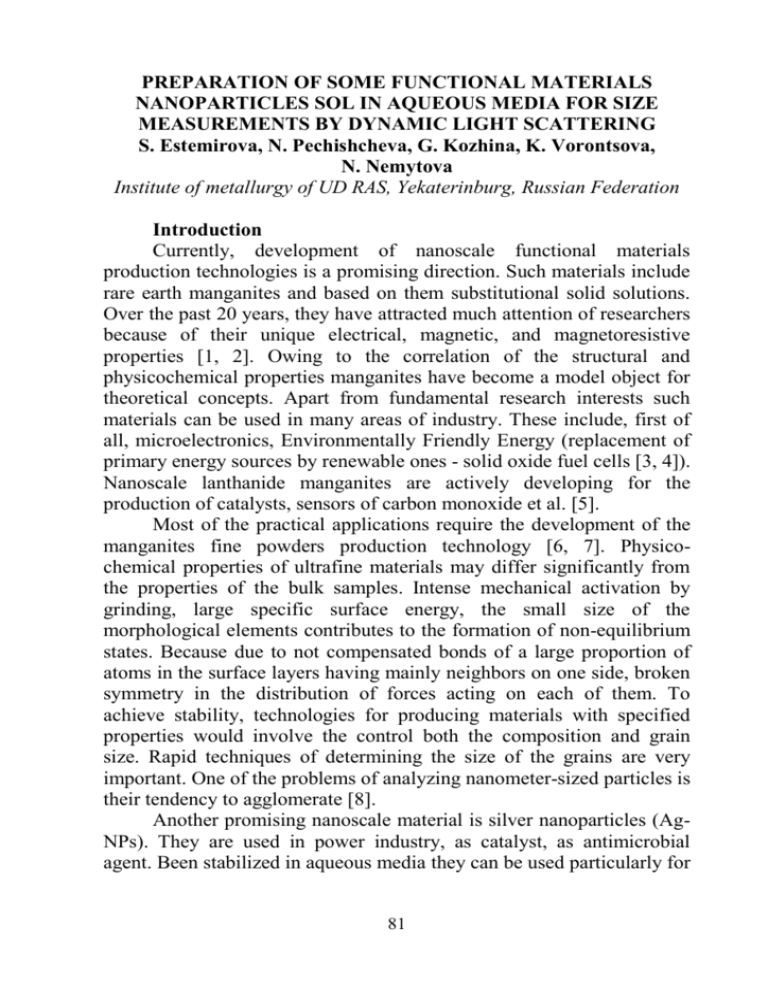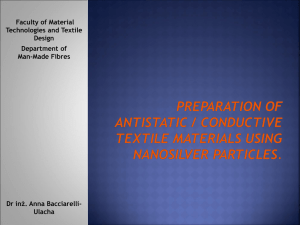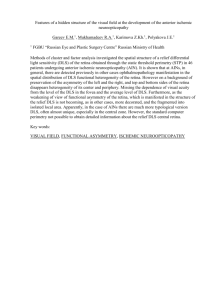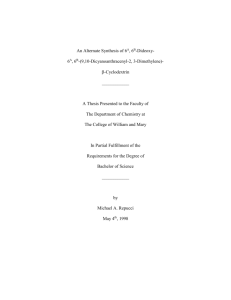Paper
advertisement

PREPARATION OF SOME FUNCTIONAL MATERIALS NANOPARTICLES SOL IN AQUEOUS MEDIA FOR SIZE MEASUREMENTS BY DYNAMIC LIGHT SCATTERING S. Estemirova, N. Pechishcheva, G. Kozhina, K. Vorontsova, N. Nemytova Institute of metallurgy of UD RAS, Yekaterinburg, Russian Federation Introduction Currently, development of nanoscale functional materials production technologies is a promising direction. Such materials include rare earth manganites and based on them substitutional solid solutions. Over the past 20 years, they have attracted much attention of researchers because of their unique electrical, magnetic, and magnetoresistive properties [1, 2]. Owing to the correlation of the structural and physicochemical properties manganites have become a model object for theoretical concepts. Apart from fundamental research interests such materials can be used in many areas of industry. These include, first of all, microelectronics, Environmentally Friendly Energy (replacement of primary energy sources by renewable ones - solid oxide fuel cells [3, 4]). Nanoscale lanthanide manganites are actively developing for the production of catalysts, sensors of carbon monoxide et al. [5]. Most of the practical applications require the development of the manganites fine powders production technology [6, 7]. Physicochemical properties of ultrafine materials may differ significantly from the properties of the bulk samples. Intense mechanical activation by grinding, large specific surface energy, the small size of the morphological elements contributes to the formation of non-equilibrium states. Because due to not compensated bonds of a large proportion of atoms in the surface layers having mainly neighbors on one side, broken symmetry in the distribution of forces acting on each of them. To achieve stability, technologies for producing materials with specified properties would involve the control both the composition and grain size. Rapid techniques of determining the size of the grains are very important. One of the problems of analyzing nanometer-sized particles is their tendency to agglomerate [8]. Another promising nanoscale material is silver nanoparticles (AgNPs). They are used in power industry, as catalyst, as antimicrobial agent. Been stabilized in aqueous media they can be used particularly for 81 certified reference material (CRM) making for quality control of nanoproducts by light scattering methods. The hydrosols have good stability; they typically may have such certified characteristics as particles size, silver concentration, maxima location and intensity of the plasmon resonance band. In the paper [9] stabilization of Ag-NPs in cyclodextrin (-CD) aqueous solution for CRM preparation have been described, but they haven’t particles size as certified characterictic. The aim of the present work is to develop methods of express estimation of grain size of the pure and substituted rare earth elements manganites solid solutions and Ag-NPs/-CD hydrosol by dynamic light scattering (DLS) method. Much attention has been paid to the methods of sample preparation and dispersion liquid pre-selection. Experimental In the present work we used Zetasizer Nano S90 (Malvern) dynamic light scattering analyzer. Structurally DLS analyser consists of a measuring unit with the sample compartment, a set of cuvettes and computer. Scattered light registered angle is 90º, laser power is 50 mW at a wavelength of 532 nm. Metrological characteristics of the analyzer: measurement range of particle size - from 10 to 5000 nm, the limits of permissible relative error of particle size measurement - ± 10%. The DLS method consists in determining the size of the dispersed particles in liquid based on diffusion coefficient determined by the analysis of the characteristic intensity fluctuations time of the light scattered by the particles. Particles in suspension, in probing them with a laser beam scatter light, which is going at a certain angle and registered by the photodetector. Fluctuations of the scattering intensity arising from the Brownian motion of the particles are analyzed by a correlator. On the basis of the correlation function containing information about the diffusion coefficient particle size is calculated by software. The measurement results are presented on the screen in both numerical and graphical form. Measurement of the particles size using analyzer Zetasizer Nano S90 requires a knowledge of the refractive index (n), dynamic viscosity (), specific density () of the dispersion liquid. Measurement of the refractive index was performed using a refractometer IRF-454-B-2M, kinematic viscosity - using a capillary viscometer VPZh-1m; to measure 82 the density we used pycnometry method. The dynamic viscosity is calculated as =.. For example 0.2% solution of benzalkonium chloride (cationic surfactant) has following characteristics at 25 ºC: n = 1.3325, = 997 kg / m 3, = 0.001014 Pa·s. Results and discussion Manganites. As objects of study we used samples of rare earth elements manganites solid solutions Nd(Gd)xCa1-xMnO3± (х=0.00, 0.10). Samples were synthesized by ceramic technology from rare earth oxides Nd2O3 (Nd-E brand), Gd2O3 (GdO-D brand), Mn2O3 (SigmaAldrich, > 99% of the main substance) and CaCO3 (reagent grade). According to X-ray data (Shimadzu XRD-7000 diffractometer, CuKradiation), all the samples were single-phase and had a perovskite orthorhombic structure (space group Pnma). To obtain ultrafine powders all the synthesized samples were subjected to mechanical activation by dry grinding in high-energy planetary mill Pulverizette 7 premium line (Fritsch) with a tungsten carbide headset, the rotational speed of the grinding jars was 800 rev/min. Then, the powder was frayed under ethanol during 10 min. At first we used solution of the anionic surfactant as dispersion liquid. It was assumed that during the mechanical action of oxygen leaves the sites of the crystal lattice of the surface layers, after which the surface may have a slight positive charge. For measurement 2% aqueous solution of sodium dodecyl sulfate (C12H25SO4Na) was prepared, manganite samples were added and mixed. Large scatter in the data after the first measurements could be the result of the presence of particle agglomerates. Ultrasonic treatment of the suspension for 1 hour (Sonopuls mini20 device, Bandelin, ultrasonic frequency 30 kHz, ultrasonic sensor MS 2.5) reduced the scatter of the three measurements results. However (see Fig. 1a) it was still unsatisfactorily large. Further measurements were carried out in 0.2% solution of benzalkonium chloride. In three parallel experiments for each composition (see Fig. 1b) the results have a good reproducibility. 83 Fig. 1. Results of measurements of Nd(Gd)xCa1-xMnO3± (х=0.00, 0.10) solid solution samples particles size (3 parallel measurements): а – dispersed in anionic surfactant (C21H38ClN); b – dispersed in cationic surfactant (C21H38ClN). From this it follows that the surface of the grain after mechanical activation has a slight negative charge. Possible cause of the charge may be adsorption of air gazes and moisture during mechanical activation, which, after their interaction with the elements of the main phase, formed a new metastable phase on the surface of the grains. Small 84 amounts of these phases as well as the small size of the crystallites of both surface and the main phase do not allow detecting the impurities by X-ray diffraction method. The reason for this is that a small grain size results in strong broadening of the diffraction maxima at small angles and in their complete disappearance at large angles. In the table 1 results of DLS measurements of the particles size with benzalkonium chloride as dispersant and CSR size of the investigated manganites are presented. One can see that CSR data in ~ 4 times less than size from DLS measurements. Table 1. Microstructure parameters of the Nd(Gd)xCa1-xMnO3± (х=0.00, 0.10) solid solution powders Composition NdMnO3± Nd0.9Ca0.1MnO3± GdMnO3± Gd0.9Ca0.1MnO3± Particles sizes in maxima of distribution, nm 148 138 158 148 CSR size, nm 30 36 53 30 Probable cause of the difference between the two different methods results may not only be large defective surface of the grains, but also the existence of small agglomerates in the aqueous media, which can not be destroyed by sonication. In addition, the lack of DLS particles size measurement is the formation of a shell of the stabilizer on the particle surface, which also increases its size. Shed light on the true size of the powder particles can further studies, for example, by electron microscopy, which, however, is rather time-consuming. However, studies show sufficiently acceptable results, especially taking into account simplicity and rapidity of the DLS procedure. It is possible that results could be improved, for example, increasing the time of sonication, and conducting a search for the more suitable dispersion liquid. Ag-NPs/-CD. Although hydrosols of Ag-Nps (1.310-4 М of silver) in alkaline (pH=10.5) solution of -CD after microwave treatment is stable enough (for 6 month) to be silver concentration and 85 plasmon resonance band certified reference material, measurements of the sol particles size by DLS method did not give satisfactory results. One can see in Fig. 2, that particles size measured 3 times in 3 min are very different. Fig.2. Results of measurements of Ag-Nps in -CD not filtered sol samples particles size (3 parallel measurements). It has been suggested that this may be caused by agglomeration of cyclodextrin molecules. Therefore, filtration of cyclodextrin solution was conducted using Millipore membrane filters (mixed cellulose esters, Hydrophilic, 0.05 µm) before synthesis and after synthesis of Ag-NPs/CD. In addition, we carried out multifactorial experiment, varying pH, silver concentration, ratio Ag/-CD concentration, time of the microwave treatment, stabilization time after preparation. Optimal parameters have been found: pH=10.0, 1.0 M Ag, Ag/-CD =10, MW treatment time – 80 s, stabilization time – 4 days. As a result of the research we have achieved stability of the studied hydrosols for 4 months. Fig.3 is demonstrating results of 3 consecutive DLS measurements of Ag-NPs/-CD optimal composition hydrosol. Together with measurements of our sol particle size we have reproduced a certified Ag-NPs size of Russian CRM 9967 and satisfactory results have been obtained: certified value of hydrodynamic diameter is 69.5 3 nm, found value is 72.1 0.07 nm. 86 Fig.3. Results of measurements of Ag-Nps in -CD filtered sol samples particles size (3 parallel measurements). Thus, we have obtained a hydrosol having a mean particle size 18.6 ± 0.6 nm (n = 10) which can be used as material for CRM preparation. It should be noted that DLS size in this case also is greater than gives another method, namely, scanning microscopy (10 nm is obtained for dried in vacuum particles on carbon adhesive tape with Auriga Carl Zeiss microscope) Probably microscopy gives only the size of the silver core composite particles. Conclusion The possibility of DLS using in aqueous media was shown to determine the particle size of powders of perovskite manganite Nd(Gd)xCa1-xMnO3± , treated by grinding in a high-energy planetary ball mill. As the dispersion liquid 0.2% aqueous solution of benzalkonium chloride (cationic surfactant) was used. Sonication of the suspension was used to break up agglomerates. Method of pretreatment of the Ag-NPs/-CD sol also was developed for reproducible DLS measurements. The results of measurements of size distribution for manganites and Ag-NPs are compared with those obtained by the other methods. DLS gives higher results, probably caused by stabilizer layers, but it is good for quick size estimation. Ag-NPs/-CD sol obtained in the present work may be used as source for stable certified reference material preparation. 87 Acknowledgments This work was financially supported by Presidium of UD RAS, project № 14-3-NP-143. 1. 2. 3. 4. 5. 6. 7. 8. 9. References Jirak Z., Damay F., Hervieu M., Martin C. / Phys.Rev. B. 2000. V.61. P.1181. Urushibara A., Moritomo Y., Arima T., Asamitsu A., Kido G., Tokura Y. / Phys.Rev. B. 1995. V.51. P.14103. Doroftei C., D. Popa P., Rezlescu E., Rezlescu N. / Journal of Alloys and Compounds. 2014. V.584. P.195–198. Takeda Y., Tu H. Y., Sakaki H., Watanabe S., Imanishi N. and Yamamoto O. / .J Electrochem. Soc. 1997. Vl. 144. N. 8 Sarita R., Kawano T. / Sensors and Actuators B. 1997. V.40. P.29-32. Mukhopadhyay J., Maiti H. S., Basu R. N. / Journal of Power Sources. 2013. V.232. P.55-65. McCarthy B.P., Pederson L.R., Chou Y.S., Zhou X.-D., Surdoval W.A., Wilson L.C. / Journal of Power Sources. 2008. V.180. P.294–300. Timoshchuk E.I.., Samoylov V.M., Timoshchuk E.V., Smirnov V.K. / Industrial laboratory. 2010. V.76. №5. P.26-29. (in Russian). Оsintseva Е.V., Pechishcheva N.V., Vorontsova K.A., Kremleva О.N., Таbаtchikova Т.N. Production of certified reference materials for composition and properties of colloidal solution of silver nanoparticles / Standartnye obraztcy (Certified Reference materials). 2012. №1. P.43-52.(in Russian). 88










